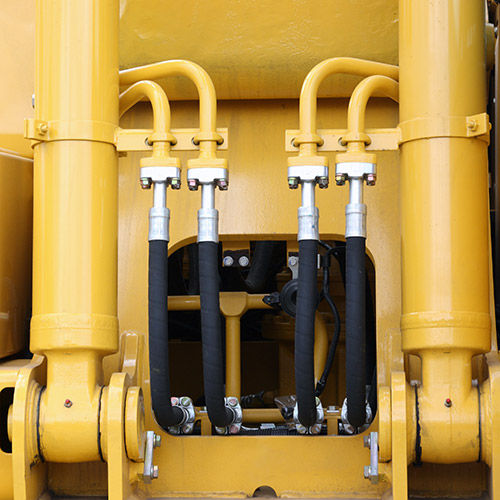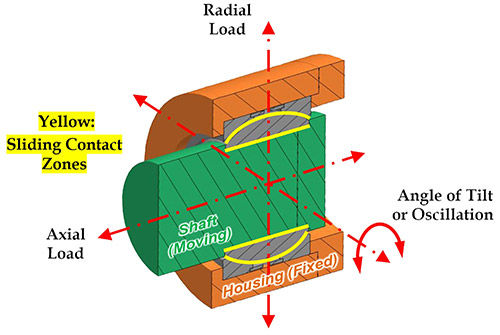A typical excavator or backhoe has a half dozen cylinders, or more, for the bucket, boom, dipper, outriggers, steering, and other equipment and accessories on the vehicle where these bearings are used, in addition to steering linkages, shock absorbers, and pivot points.
Spherical plain bearings are available in various types and configurations to address specific loading and operating conditions, and environmental conditions.
Spherical plain bearing configurations (Upper Left: Standard, with misalignment Angle α; Upper Right: With higher misalignment Angle β; Lower Left: Extended inner ring; Lower Right: Seal type).
Sealed Type
Spherical plain bearings are available with seals to protect the sliding surfaces in severe environments. The seals are affixed to the outer ring and make positive contact with the inner ring keeping dirt and debris out, and the lubricant in. Variations in seal materials and design vary from manufacturer, but most seals are either a polyester elastomer material or a buna nitrile rubber bonded to a sheet steel insert. These plastic and rubber seals are best suited for applications where the bearings see frequent tilting or circumferential movement. This tends to keep the contact surfaces clean.
Extended Inner Ring
To ease assembly, and eliminate the need for spacers, these bearings are also available with an extended inner ring design. These have a slightly higher cost.
High Angle
Depending on their size, most spherical plain bearings accommodate misalignment in the 5 to 15 degree range. However, higher angles of misalignment can be accommodated with a special series. This series has an increased cross section inner ring which allows for the higher angle of tilt, up to 20 degrees.
Cross sectional view of spherical plain bearing installed with shaft and housing. Radial and axial load axes, sliding contact zones.
Impact Resistant
In some off highway applications shock or impact loading is common and can have a devastating effect on bearings. Most spherical plain bearings are manufactured from thru hardened 52100 chrome steel. These bearings have good wear resistance and fatigue strength. However, with their high hardness, they are susceptible to chipping, cracking, and breaking under these conditions. Spherical plain bearings manufactured from low carbon, carburizing steels, such as 8620, and processed with a special heat treatment known as case hardening are recommended in these applications. The case hardening provides an outer layer of high hardness for wear resistance and fatigue and the core of the bearing is “softer”, or more ductile, which allows the bearing to absorb impact. These bearings carry a price premium.
Loading and life
Spherical plain bearings can accommodate loads in both the axial and radial directions, with the load predominantly radial for the latter. Angular contact types are available for heavier thrust or axial loading. Loads can be in combination, and the direction constant or alternating.
Other loading considerations:
- Loads are dynamic when sliding movements take place in a loaded bearing, causing wear in the bearing.
- Dynamic loads can be oscillatory or rotational. Oscillatory loads can be accommodated only along the lateral axis and are limited to the angle of misalignment, or tilt, designed into the bearing.
- The higher the frequency of oscillation, the lower the bearing life for a given application.
- Under static load, the limiting factor is the strength of the material of the bearing or rod end.
While these bearings have very straightforward construction and operating principles, calculating service life is tricky — so engineers are advised to contact the manufacturer for assistance. The values of load ratings depend on the definition used, so it’s not always possible to make direct comparisons with load ratings published by each manufacturer.
Dynamic load rating
Dynamic load rating is used for calculations when the spherical plain bearing is subject to dynamic stress. It represents the load, constant in magnitude and direction, under which a basic rating service life, expressed as a sliding distance, will be attained for continuous oscillating movement at a defined sliding velocity at room temperature. It assumes that the load acting on radial and angular spherical plain bearings and on rod ends is purely radial, and that the load acting on spherical plain thrust bearings is purely axial and acts centrically. Dynamic stresses often occur in combination: when tilting, oscillatory or rotational movements are made under load; with micro-sliding movements under alternating loads; and with loads alternating at high frequency.
Static load rating
Static load rating is used when spherical plain bearings remain stationary under load, with only occasional alignment movements. It should be considered when dynamically loaded bearings are subject to heavy shock loads.
The static load rating represents the load which can be taken by a spherical plain bearing when static contact stress of the bearing contact surface reaches the material stress limit. It is valid at room temperature and it assumes that the surrounding components prevent deformation of the bearing.
At higher temperature, it must be multiplied by a temperature factor dependent on the sliding contact surface combination. The temperature factor is the same as for a dynamically stressed bearing. It is also necessary to take into consideration the permissible temperature range for the various sliding contact surface combinations. For rod ends, this is the strength of the rod end housing under stationary load. The rod end static load ratings give a safety factor of 1.2 times the tensile strength of the rod end housing material.
Service life
The service life of a spherical plain bearing is expressed as the number of oscillating movements, or the number of operating hours, which the bearing will endure before a defined increase in bearing clearance or a defined increase in friction is reached.
The service life of a spherical plain bearing operated under mixed or dry friction conditions is determined by the increase in bearing clearance / bearing friction caused by progressive wear of the sliding surfaces, plastic deformation of the sliding material, and fatigue of the sliding surface. Depending on the application, the permissible wear and increase in friction will be different — meaning the service life which can be obtained in practice will be different, even under the same operating conditions.
The effective service life is how long a given spherical plain bearing lasts under actual operating conditions. It is primarily determined by the magnitude and type of load, as well as contamination, corrosion, high-frequency load and movement cycles, and shock. Some of these factors are impossible to determine or can only be determined with difficulty.
 John Wallace is a degreed Mechanical Engineer with over 30 years of industry experience in Engineering, Manufacturing, and Quality Assurance. He has been Vice President of Operations at AST Bearings since 2003. John can be reached at John.Wallace@astbearings.com
John Wallace is a degreed Mechanical Engineer with over 30 years of industry experience in Engineering, Manufacturing, and Quality Assurance. He has been Vice President of Operations at AST Bearings since 2003. John can be reached at John.Wallace@astbearings.com
 Steven Sanchez, P.E. is a degreed Mechanical Engineer, a licensed Professional Engineer in the State of New Jersey, and a BSA Certified Bearing Specialist with over 25 years of industry experience in Engineering & Manufacturing. He has been the Engineering Manager of AST Bearings since 2013. Steven can be reached at Steven.Sanchez@astbearings.com
Steven Sanchez, P.E. is a degreed Mechanical Engineer, a licensed Professional Engineer in the State of New Jersey, and a BSA Certified Bearing Specialist with over 25 years of industry experience in Engineering & Manufacturing. He has been the Engineering Manager of AST Bearings since 2013. Steven can be reached at Steven.Sanchez@astbearings.com
Lubrication
Metal-on-metal spherical plain bearings
For spherical plain bearings requiring maintenance (metal-on-metal), lubrication increases a bearing’s life by reducing friction and wear, with the added benefits of reducing noise and providing a barrier against corrosion.
In order for the lubrication to be effective, the grease must flow into the load areas — the contact zone between the inner and outer ring. When the grease cannot flow into the load zone, the bearing must be unloaded in order to effectively lubricate it. Regular re-lubrication of the bearing during its operation, on an established schedule that’s re-examined when operating conditions change, will substantially extend its service life. NLGI grade 2 greases with EP additives are recommended.
Insufficient lubricant in the load zone allows for metal to metal contact and leads to premature bearing failure. Bearings with special groove patterns on the inner ring (ball) are available that increase bearing life in dirty and extreme environments. These grooves promote more efficient lubricant distribution by providing additional channels to move lubricant into the load zones. In addition, the grooves move and capture dirt and debris thus keeping these contaminants off the raceway surfaces. These bearings also carry a price premium.
Maintenance-free steel-on-PTFE spherical plain bearings
For steel-on-PTFE lined (fabric or composite) spherical plain bearings, it’s important to refrain from additional lubrication. Any lubrication of the sliding contact surfaces could disturb the internal self-lubricating properties and shorten the bearing’s service life.
When operating conditions require enhanced sealing and protection against corrosion, it is recommended to fill the space surrounding the bearing with lithium-based grease.
Summary
Radial spherical plain bearings serve an important function within the off highway world, particularly in the construction, forestry, and agricultural sectors, because they’re crucial to the equipment and vehicles used in those industries. They’re key to OEMs’ ability to create reliable products that endure extreme environments. Knowing the basics about radial spherical plain bearings, and how they compare to other commonly used components, is fundamental to making good design choices.
www.astbearings.com











